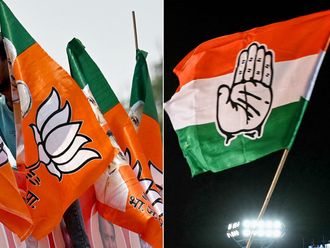In India the Congress party’s manifesto for the 2024 Lok Sabha elections released earlier this month focuses on a key issue -- jobs. Job creation is a major focus of the party document which lists out several promises in this direction.
The first is a Right to Apprenticeship Act where every college graduate or diploma holder under the age of 25 will get a one year apprenticeship with a private or a public sector company with a stipend of Rs1 lakh. Another important pledge by the Congress is to fill the nearly 30 lakh vacancies in government jobs at the centre.
Other job generation ideas include changing the scheme to fund start ups which would provide money to those below the age of 40 to start their own businesses. Application fees for government examinations and posts will also be abolished if the Congress comes to power.
There is also a promise to launch an urban employment programme guaranteeing work for the urban poor in reconstruction and renewal of infrastructure, increase wages under age MGNREGA, as well as the national minimum wage.
They have also said they will bring in a law to protect the rights of gig and unorganised workers and enhance their social security. Corporates are promised tax credits in a new employment linked incentive scheme for additional hiring.
Mismatch of skills
On paper, this is a significant road map for job creation in India by the Congress party. They hope that unemployment will become the key issue of the campaign for most voters especially since India has the largest population of young people. A glance at the data tells us jobs should be the big focus of all parties but the actual campaign is likely to descend into other noisy stuff.
According to the Centre for Monitoring Indian Economy (CMIE), India is facing an unemployment problem among the youth, especially graduates, as white collar jobs such as those in the information technology sector have been on the decline.
Their latest data shows that in the October to December in 2023, unemployment in India’s youth aged 20 to 24 years rose to 44.49%, from 43.65% in the previous quarter. Unemployment among 25- to 29-year-olds rose to 14.33% during the same period from 13.35% in the prior quarter.
In the IT sector, the growth of technology is partly to blame making some roles redundant -- aproblem which is not unique to India. What is a problem is a mismatch of skills, where young people are training for the IT sector but the jobs simply can’t keep pace. Jobs in the manufacturing sector have however risen.
“Very small rebound”
A recent study done by D. Tripati Rao of the Indian Institute of Management (IIM), Lucknow, in collaboration with researchers from Birla Institute of Technology and Science, Pilani and the Union Ministry of Agriculture and Farmers Welfare, says the economy is witnessing a stagnating employment growth rate, low female labour force participation and a rise in the unemployment rate.
Their data shows jobless growth from 2004-5 to 2018-19 and a “very small rebound” thereafter. A big focus of their study is the quality of jobs being created. The CMIE has also stressed on the poor quality of jobs being created in India. The unemployment rate in India also rises with education levels.
The BJP government has been dismissive of these numbers and of the issue of unemployment in general. In November last year, one of the economic advisers to the Prime Minister Sanjeev Sanyal, said there is no such thing as jobless growth.
“If you have growth, you will generate jobs and therefore the fact of the matter is we are maintaining good growth rates 6.5% to 7% right now under difficult international circumstances. If those circumstances change, we will generate even higher growth," he said. That doesn’t explain why thousands of Indian workers are looking for jobs in places like Israel.
India is one of the fastest growing economies in the world today. That is important at a time when global headwinds have slowed down countries like China. But this growth needs to be urgently accompanied by growth in quality jobs. India has the demographic advantage. It now needs the political will to see this through.









